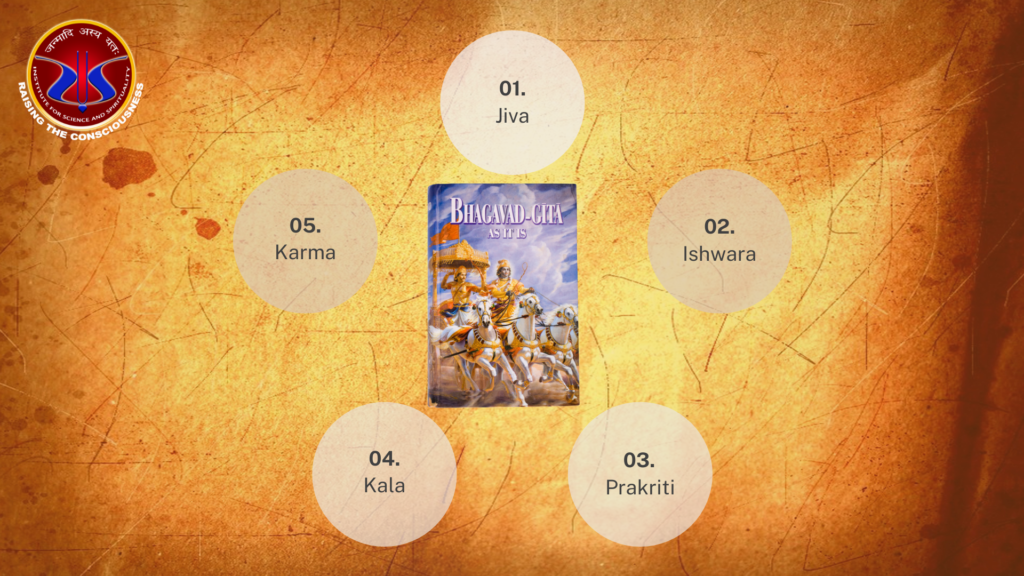Namaste, dear readers!
In this edition of Samyak Drishti, we delve deeper into the teachings of the Bhagavad Gita, also known as Gītopaniṣad, which stands as the essence of Vedic knowledge and one of the most important Upaniṣads in Vedic literature.
The Gita’s relevance goes far beyond religious boundaries. It provides a framework for understanding life, the universe, and our role within it. But, to truly comprehend its teachings, one must approach it with an open heart and a spirit of devotion, accepting Lord Krishna as the Supreme Personality of Godhead, as it is emphasized throughout the Gita.
The spirit of Bhagavad-gītā is mentioned in Bhagavad-gītā itself. It is just like this: If we want to take a particular medicine, then we have to follow the directions written on the label. We cannot take the medicine according to our own whim or the direction of a friend. It must be taken according to the directions on the label or the directions given by a physician. Similarly, Bhagavad-gītā should be taken or accepted as it is directed by the speaker Himself. The speaker of Bhagavad-gītā is Lord Śrī Kṛṣṇa. He is mentioned on every page of Bhagavad-gītā as the Supreme Personality of Godhead, Bhagavān.
Taking the Bhagavad Gita as It Is
Many English translations of the Bhagavad Gita exist, but unfortunately, many commentators inject their personal opinions into the text, drifting away from the true spirit of the Gita. Just as one must follow a doctor’s prescription precisely to heal, the Gita must be approached according to the directions of Krishna Himself. Without a submissive and devotional spirit, the deeper mysteries of this sacred text will remain hidden.
The Bhagavad Gita is a guide to help mankind rise above the struggles and anxieties of material existence. When Arjuna, on the battlefield of Kurukshetra, was engulfed with doubt and moral confusion, he surrendered to Lord Krishna, and thus, the Bhagavad Gita was spoken.
But Arjuna’s plight is not unique. Each of us, in our daily lives, faces similar challenges—anxieties about choices, dilemmas in performing our duties, and existential crises about our purpose. Krishna’s teachings were not only for Arjuna; they are for every individual striving to overcome the material nature and connect with the eternal truth.
How Arjuna Accepted the Teachings
The profound manner in which Arjuna accepted Krishna’s teachings is a lesson in humility and surrender. In the Tenth Chapter (10.12–14), Arjuna unequivocally declares Krishna as the Supreme Personality of Godhead—paraṁ brahma, the purest, eternal truth.
Arjuna’s acceptance of Krishna as the supreme being is not born out of friendship but is supported by the authority of great sages like Nārada, Asita, Devala, and Vyāsadeva. Arjuna’s words affirm that even great demigods and scholars cannot comprehend Krishna’s true nature. Only through devotion and surrender can one begin to grasp His divine personality.
The Spirit of Devotion
To truly understand the Gita, one must approach it with devotion. Lord Krishna is not just a historical figure or a great personality—He is the Supreme Godhead. It is only by accepting this that one can unlock the true teachings of the Gita.
Without this humble approach, the Bhagavad Gita can remain a mystery. The teachings are meant to free us from the anxieties and limitations of material existence and guide us towards a life of purpose, spiritual growth, and eternal happiness.
Five Basic Truths of the Gita
The Bhagavad Gita explains five fundamental truths that govern both the material and spiritual realms:
- Īśvara – The Supreme Controller, God, represented by Lord Krishna.
- Jīva – The living entities, who are controlled. While we may feel autonomous, we are, in reality, bound by material nature.
- Prakṛti – Material Nature, the force that binds and governs the physical world.
- Kāla – Time, which controls the duration of existence for all material manifestations.
- Karma – Action or activity, the deeds performed by living entities, which produce corresponding results in this life and beyond.
Understanding these truths helps us comprehend the nature of existence. The Gita teaches that while we may be bound by material nature and time, we are eternal beings meant for liberation and divine union with Krishna.
In the coming editions, we will continue to explore these takeaways in more detail, allowing the wisdom of the Bhagavad Gita to guide us in navigating our day-to-day lives with greater clarity and spiritual insight.
✨ Subscribe to Samyak Drishti and walk with us on this journey of timeless wisdom from the Bhagavad Gita and other Vedic texts. ✨
References and Source:



